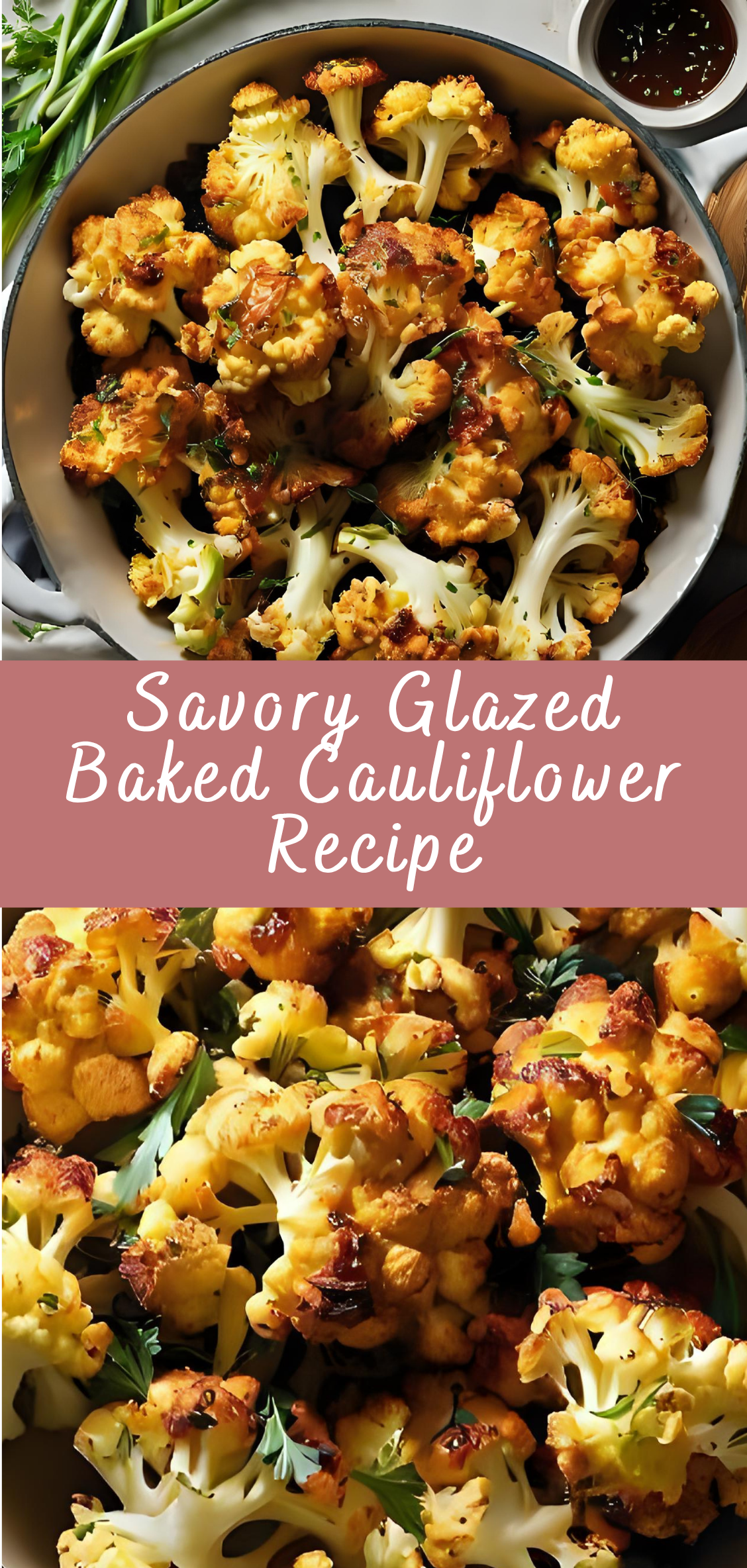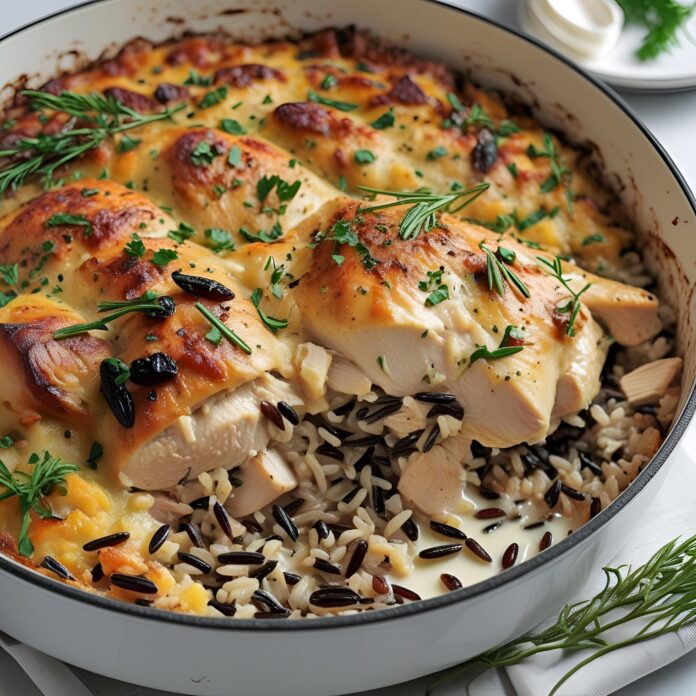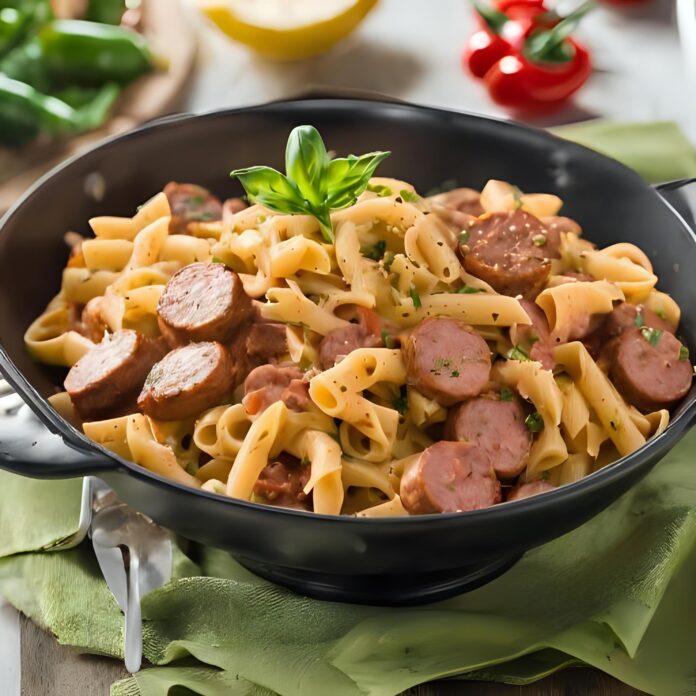Savory Glazed Baked Cauliflower Recipe
In an age where vegetables are no longer relegated to the sidelines of our plates, cauliflower has emerged as one of the most versatile, captivating, and unexpectedly elegant ingredients in modern cooking. Once dismissed as bland or boring, this humble crucifer has risen to the forefront of plant-based cuisine, thanks in part to its remarkable ability to absorb flavor, its satisfying texture, and its dramatic visual potential when presented whole or roasted. And few dishes showcase cauliflower’s full potential as brilliantly as a Savory Glazed Baked Cauliflower.

This dish is not simply a side—it is a statement. It’s what you serve when you want a meatless main that still has presence, heft, and complexity. With its deeply roasted edges, its glossy, umami-rich glaze, and its tender-yet-structured interior, this baked cauliflower captures the essence of thoughtful, satisfying plant-forward cooking. It’s the kind of recipe that makes people pause mid-bite and ask, “Wait—this is cauliflower?”
Rooted in culinary traditions from the Middle East to South Asia to California’s vibrant plant-based food scene, this recipe borrows techniques and flavor profiles from a range of global influences. The idea is simple: take a whole (or sectioned) head of cauliflower, treat it with reverence, and layer it with deep, savory elements—roasting it until it’s golden, basting it with a bold glaze, and finishing it with a flourish. Whether you’re glazing it with soy and miso, balsamic and garlic, harissa and honey, or tahini and tamari, the cauliflower becomes a blank canvas that transforms under heat and seasoning.
But what sets this dish apart isn’t just the technique—it’s the intention. Cauliflower, when baked and basted thoughtfully, becomes something both luxurious and grounding. It can be carved like a roast, plated like a steak, or pulled apart at the table for sharing. It brings people together. It surprises them. It invites creativity and generosity, two values that sit at the heart of great cooking.
Moreover, the beauty of this dish lies not just in its appearance but in its adaptability. It can be prepared in advance and reheated gracefully. It works just as well as a weeknight dinner centerpiece as it does for a special occasion menu—vegan holiday meals, dinner parties, or even Sunday suppers where meat isn’t missed. You can serve it with a creamy dip or grain salad, nestle it atop hummus, or pair it with a vibrant chimichurri or herb oil drizzle.
In the sections that follow, we’ll walk through every detail of preparing a perfect Savory Glazed Baked Cauliflower—from choosing the right head, prepping and parboiling for ideal tenderness, crafting a flavor-dense glaze, baking to golden perfection, and finishing with balance and flair. You’ll also find tips for different glazes (balsamic-miso, harissa-maple, gochujang-tamari, and more), serving ideas, make-ahead instructions, and substitutions for all dietary needs.
This is more than a recipe—it’s an invitation to rethink how we cook, serve, and celebrate vegetables. Whether you’re a long-time plant-based eater or someone just looking to expand your weeknight repertoire, this dish offers the opportunity to experience cauliflower in an entirely new light: complex, confident, and utterly craveable.
So, heat up your oven, sharpen your knife, and get ready to transform a simple head of cauliflower into a centerpiece worthy of praise.
Detailed Instructions: Creating the Perfect Savory Glazed Baked Cauliflower
A beautifully baked cauliflower is more than a roasted vegetable—it’s a structured, layered dish that requires care, attention to timing, and well-balanced flavor. The following instructions break down each stage, from selecting the right head to preparing it for baking, applying the glaze, and serving it like a true centerpiece.
Step 1: Select and Prep the Cauliflower
The journey begins with choosing the best possible cauliflower, because the structure, moisture, and freshness of the vegetable will greatly affect the outcome.
Choosing the Cauliflower:
-
Select a firm, tight head with creamy white florets and no dark spots or bruising.
-
A medium-to-large head (about 2 to 2.5 pounds) is ideal if you’re baking it whole.
-
The leaves should be green, fresh, and crisp—this indicates recently harvested produce.
Prepping the Cauliflower:
-
Trim off the leaves and cut the stem so the cauliflower can sit upright without wobbling.
-
Leave the core intact if baking whole; it holds the florets together during roasting.
-
Rinse the cauliflower well and pat it completely dry—moisture will interfere with roasting and caramelization.
Step 2: Pre-Cook for Tenderness (Optional but Recommended)
Whole cauliflower heads are dense, and roasting them from raw can result in an overbrowned exterior before the interior is tender. A quick parboil (or steam) ensures even cooking and a creamy texture throughout.
Boiling Method:
-
Bring a large pot of salted water to a gentle boil.
-
Carefully lower the cauliflower head into the pot, core side down.
-
Boil for 7–8 minutes, just until the outer part is slightly tender.
-
Remove with tongs or a slotted spoon, and let cool for 10–15 minutes on a towel or rack.
Steaming Method:
-
Use a steamer basket over boiling water.
-
Steam the cauliflower for 10–12 minutes until a knife pierces it with light resistance.
Tip: Do not overcook—the cauliflower should be partially tender but not falling apart.
Step 3: Prepare the Glaze
Here’s where the flavor magic happens. The glaze is what transforms a humble cauliflower into something savory, glossy, and bold. The standard version here is a balsamic-miso glaze, but others are included later in this recipe.
Balsamic-Miso Glaze:
-
2 tablespoons white or yellow miso paste
-
2 tablespoons balsamic vinegar
-
2 tablespoons olive oil
-
1 tablespoon maple syrup or honey
-
1 tablespoon Dijon mustard
-
1 teaspoon soy sauce or tamari
-
2 cloves garlic, finely grated
-
Freshly ground black pepper, to taste
Instructions:
-
In a small bowl, whisk all ingredients until smooth and emulsified.
-
Taste and adjust: Add more vinegar for tang, miso for depth, or syrup for sweetness.
Tip: The glaze should be thick enough to cling to the cauliflower but fluid enough to brush on evenly.
Step 4: Roast the Cauliflower
This is the transformation phase—where texture, flavor, and visual appeal all come together.
Initial Roast (No Glaze):
-
Preheat your oven to 425°F (220°C).
-
Place the cauliflower in a cast-iron skillet, roasting pan, or baking sheet lined with parchment.
-
Brush lightly with olive oil, sprinkle with salt, and roast uncovered for 15–20 minutes.
Glaze and Roast:
-
Remove the cauliflower from the oven.
-
Using a pastry brush, generously apply the glaze over the top and sides.
-
Return to the oven and roast for an additional 25–30 minutes, glazing again halfway through. Baste more glaze on during the last 5–10 minutes to build a glossy, caramelized finish.
-
If the top begins to brown too quickly, tent loosely with foil and continue roasting.
How to Tell It’s Done:
-
Insert a sharp knife into the core—there should be little resistance.
-
The glaze should be caramelized and slightly sticky.
-
The exterior should be golden brown with crisp edges, while the inside remains tender.
Step 5: Let It Rest and Finish with Flair
Resting isn’t just for meat—this step lets the cauliflower settle, which helps with slicing and presentation.
-
Remove from the oven and let rest 5–10 minutes before serving.
-
For added dimension, you can drizzle with:
-
A little extra glaze or balsamic reduction
-
Herb oil or chimichurri
-
A squeeze of lemon juice
-
Step 6: Serve as a Main or Side
Serving Suggestions:
-
Whole presentation: Serve the entire head at the table and slice like a roast.
-
Quartered or halved: Cut into wedges and plate individually.
-
Over a base: Plate over a bed of creamy hummus, lentils, or mashed potatoes.
-
With accompaniments: Add roasted chickpeas, sautéed greens, or a grain salad.
Pairing Ideas:
-
Wines: Dry Riesling, Pinot Noir, or a crisp Sauvignon Blanc
-
Side dishes: Couscous, farro, quinoa, or garlicky sautéed kale
-
Sauces: Yogurt tahini, green goddess dressing, or harissa aioli
Optional Variations and Glaze Alternatives
Harissa-Maple Glaze:
-
2 tablespoons harissa paste
-
1 ½ tablespoons maple syrup
-
1 tablespoon olive oil
-
1 teaspoon lemon juice
Gochujang-Soy Glaze (Korean-inspired):
-
1 tablespoon gochujang
-
1 tablespoon soy sauce
-
1 tablespoon rice vinegar
-
1 teaspoon sesame oil
-
2 teaspoons honey
Lemon-Tahini Glaze (Mediterranean-style):
-
2 tablespoons tahini
-
1 tablespoon lemon juice
-
1 teaspoon maple syrup
-
Warm water to thin
Each of these changes the flavor profile dramatically while keeping the method intact.
Savory Glazed Baked Cauliflower Recipe
In an age where vegetables are no longer relegated to the sidelines of our plates, cauliflower has emerged as one of the most versatile, captivating, and unexpectedly elegant ingredients in modern cooking. Once dismissed as bland or boring, this humble crucifer has risen to the forefront of plant-based cuisine, thanks in part to its remarkable ability to absorb flavor, its satisfying texture, and its dramatic visual potential when presented whole or roasted. And few dishes showcase cauliflower’s full potential as brilliantly as a Savory Glazed Baked Cauliflower.
Ingredients
- For the Cauliflower:
- 1 large head of cauliflower, cut into florets
- 2 tbsp olive oil
- Salt and pepper, to taste
- For the Savory Glaze:
- ¼ cup soy sauce (low-sodium preferred)
- 2 tbsp balsamic vinegar
- 2 tbsp honey or maple syrup
- 2 tbsp tomato paste or ketchup
- 1 tbsp Dijon mustard
- 1 clove garlic, minced
- ½ tsp smoked paprika (or regular paprika)
- ½ tsp onion powder
- 1 tbsp cornstarch + 2 tbsp water (optional, for thickening)
Instructions
- Preheat oven to 400°F (200°C). Line a baking sheet with parchment paper or lightly grease it.
- Toss the cauliflower florets with olive oil, salt, and pepper. Spread in an even layer on the baking sheet.
- Roast for 25–30 minutes, turning once halfway through, until cauliflower is golden and tender.
- While roasting, prepare the glaze:
In a small saucepan over medium heat, whisk together soy sauce, balsamic vinegar, honey/maple syrup, tomato paste, Dijon mustard, garlic, paprika, and onion powder.
Bring to a simmer and cook for 3–5 minutes. - Optional: If you'd like a thicker glaze, stir in the cornstarch-water slurry and cook another 1–2 minutes until thickened.
- Remove roasted cauliflower from the oven and transfer to a large bowl.
- Toss with the glaze until well coated.
- Return to baking sheet and bake for an additional 8–10 minutes to let the glaze set and caramelize slightly.
- Serve warm, garnished with fresh herbs (like parsley or chives) or a sprinkle of sesame seeds if desired.
Notes
- For extra texture: Add roasted chickpeas or top with toasted nuts (e.g. walnuts or almonds).
- Make it spicy: Add a dash of sriracha or crushed red pepper flakes to the glaze.
- Meal idea: Serve over rice, quinoa, or tucked into pita with tahini for a vegetarian main dish.
- Time-saver: Use pre-cut cauliflower florets.



